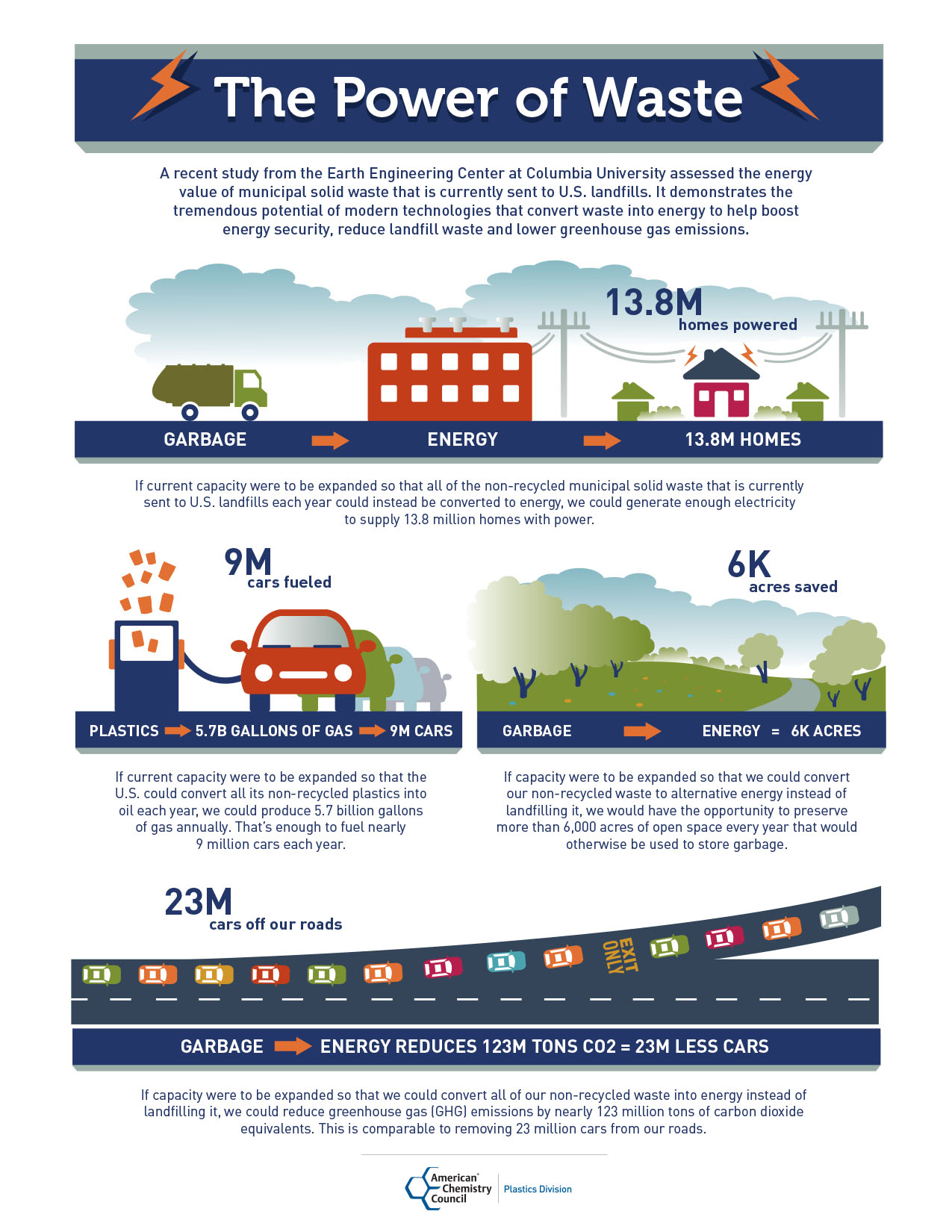Most people don’t give a second thought to where their trash goes once it’s hauled away, but thanks to exciting developments in technologies that recover energy from waste, it’s worth taking a closer look. Today, a growing number of technologies are able to turn non-recycled trash can into valuable products, including energy.
To better understand the energy potential of solid waste in the United States, ACC sponsored an initial study conducted by the Earth Engineering Center (EEC) of Columbia University in 2011. That study quantified the energy and economic value of municipal solid waste, including non-recycled plastics (using data from 2008), and the results underscored a huge, largely untapped, opportunity.
More recently, ongoing advancements in energy recovery technologies prompted ECC to update its original findings. The new study, which uses data from 2011, highlights the tremendous potential of waste as an energy resource in the U.S. and outlines the many ways that these technologies can convert waste into energy and fuel, divert solid waste from landfills, and even reduce greenhouse gas emissions.
Download Infographic: “The Power of Waste”
The latest EEC study found that:
- If we had the capacity to divert all of the solid waste that was landfilled in 2011 to waste-to-energy facilities,[i] we could generate enough electricity to supply about 13.8 million households[ii], or 12 percent of the entire United States.
- If just the non-recycled plastics in solid waste were to be source-separated and converted through today’s plastics-to-oil technologies into fuel oil[iii], they could produce 135 million barrels of oil per year – or 5.7 billion gallons of gasoline, enough to fuel 8.9 million cars
- If we could convert our non-recycled waste to alternative energy instead of landfilling it, we could preserve more than 6,000 acres of open space every year that would otherwise be used to store garbage.
In a nutshell, EEC found that our everyday trash is an abundant, domestic energy resource, and that using more of today’s technologies to unlock that energy could also bring about environmental benefits, such as lowering greenhouse gas emissions, and making better use of energy than burying it in a landfill.
States can help ensure that we’re tapping into the energy value of our waste by making sure that our regulations are broadened to include energy derived from waste toward landfill diversion goals and simplifying state permitting processes.
To learn more about energy recovery, visit: http://chemistrytoenergy.com/energy-recovery.
Be sure to check out this related video: “Beyond Recycling: Recovering the Energy in Non-Recycled Plastics“
The latest full study from Columbia University, “2014 Energy and Economic Value of Municipal Solid Waste (MSW), including and Non-recycled Plastics (NRP), Currently Landfilled in the Fifty States,” summarizes information from 2011 for the nation and each of the fifty states on quantities of non-recycled plastics available, municipal solid waste generation, and the potential energy and economic value of recovering this material. Given that the study looked exclusively at municipal solid waste, the actual amount of recoverable materials in the United States and the energy values associated with them are likely greater than those included in the scope of this study.
[i] Assuming a thermal efficiency of 0.6 MWh/ton of municipal solid waste.
[ii] According to the EIA definition (53), a household is a family or group of one to nine persons occupying the same housing unit. Under the U.S. Census Bureau definition, family households consist of two or more individuals who are related by birth, marriage, or adoption but may include other unrelated people; in 2011, the average household consisted of 2.6 people.
[iii] Assuming an efficiency conversion factor of 4 barrels of oil per ton of plastics.






